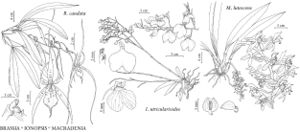Tolumnia bahamensis
Orchidee (Hamburg) 37: 59. 1986.
Plants to 12 cm (excluding inflorescence). Leaves semiterete 3–10 × 0.4–1 cm. Inflorescences 1–4, erect, to 50 cm, side branches few or none, to 4.5 cm; bracts 2–6 mm. Flowers white with red-brown spots at bases of perianth parts; sepals spatulate, 4–6 × 1–2 mm, apex apiculate; lateral sepals connate to 3/4 length; petals spatulate to pandurate, 5 × 2 mm, apex rounded to retuse, often apiculate; lip with large red-brown spots near yellow callus, 8–12 × 8–13 mm, middle lobe about 1/3 wider than combined lateral lobes, apex retuse-apiculate, isthmus 0.2–0.4 cm wide with serrate margins; callus with 2 sets of tuberculate processes, 3 proximal, broader, 2 distal, smaller; column whitish to pale lavender with yellow base and white to rose-purple column wings 5–6 mm. Capsules 1.5 cm.
Phenology: Flowering Apr–Jun.
Habitat: Terrestrial or epiphytic on shrubs and scrub trees in dry thickets
Elevation: 0–10 m
Distribution
Fla., West Indies (Bahamas).
Discussion
Tolumnia bahamensis has been regarded by some authors as a synonym or variety of T. variegata (D. S. Correll 1950; C. L. Withner 1980). Flower morphology helps little in the T. variegata complex (J. D. Ackerman and M. Galarza-Pérez 1991); T. bahamensis differs, however, by being a tetraploid (84 chromosomes) and having semiterete leaves. These features also exist in T. sylvestris (G. J. Braem 1986b), a species of eastern Cuba generally found in high elevation pine forests, a habitat somewhat different from that of either Florida or the Bahamas. Whether or not T. sylvestris and T. bahamensis are conspecific awaits further studies.
Selected References
None.
